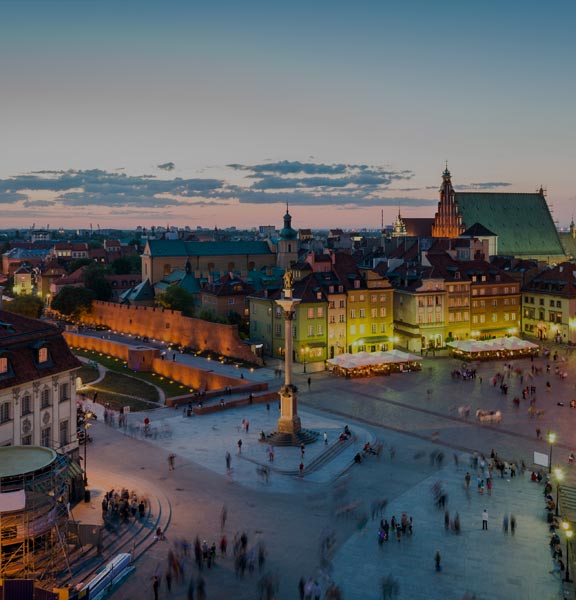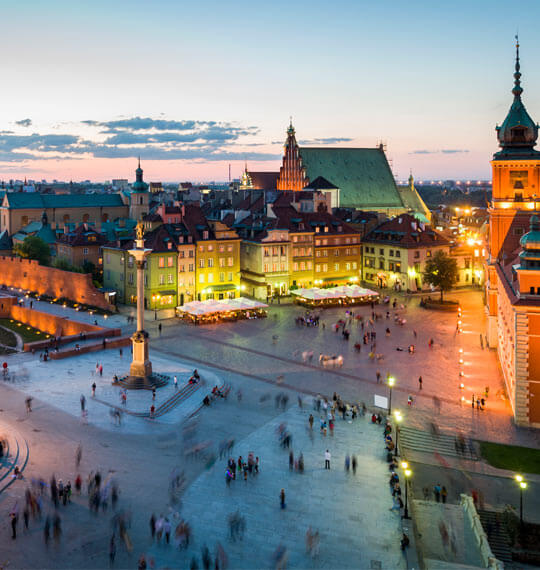A constantly changing Warsaw is aspiring to be one of the most interesting cities in the new united Europe. It is a fascinating, inspiring modern place where portfolio of art exhibitions, concerts, theatrical plays and multi-cultural restaurants is continuously expanding.
Over 52% of the Warsaw population are newcomers – people originally born outside of Warsaw. So, don’t worry, you are not the only one! Warsaw is a city of singles. Out of all registered housholds in Warsaw most of them are one-man-shows! (resouce: City Hall)
Public Transportation
Warsaw has quite a wide network of public transportation. As many other big cities, Warsaw’s traffic can be quite heavy especially during the rush hours. You might experience such full buses or subways that you would not be able to get on. There is no culture of queuing up for a bus or tram, so don’t expect others to let you in, just because you were first at the stop.
Warsaw’s subway (Metro) is one of the most modern networks in Europe. It is covered completely underground across the whole line, uncommon to most of the other European cities. The stations are very spacious and pompous. Some of the them (i.e. Wilanowska, Dworzec Gdanski, Ratusz) are used as art & history exhibitions.
There are 296 different lines of buses and trams driving through Warsaw. Buses are very common means of public transportation in Warsaw. In most cases they connect distant city districts with subway or directly city center.
Fast City Train (SKM) network is the newest means of public transportation in Warsaw. It wasn’t until Ocotber 2005 that SKM trains start transporting citizens across Warsaw. The trains are very modern and fully air-conditioned.
Where to live?
Mokotów
Space: 35,4 km²
Population: 225 914
Divisions: Siekierki, Augustowka, Sadyba, Czerniakow, Sielce, Stegny, Sluzew, Ksawerow, Wierzbno, Wygledow, Sluzewiec
Mokotów is located on the west bank of the Vistula River. This district is quite diversified, where you can find old villas rounded by city parks and other green squares next to 1920’and 1930’ blocks of flats. Some of the most luxurious apartments in Warsaw can be found there.
Embassies and ambassadors’ residencies are located in the villas part of Mokotów. This area hosts also modern office buildings and the headquarter of the Public TV (see photo), National Library and the biggest ice skating track Stegny. There is also an international european school located nearby. Hence, many expats choose Mokotow to be close to the international community.
Mokotow is a very lively area with many restaurants, cafees, wide choice of theatres (Teatr Nowy and puppet thatre for children Teatr Guliwer) as well as numerous cinemas including studio cinema Iluzjon, airing classics, and modern multiplex movie theatres located in both shopping malls: Sadyba Best Mall and Galeria Mokotów.
As it is well connected with the city through subway (stations: Wierzbno and Służew), it will take you some 10 min. to get to the central station.
Mokotów is a good choice for expats families who prefer to stay close to the center and like to feel the vibe of a city with everything that comes with it. It is also reasonable choice if you work in the nearby office district. Be aware of traffic jams though! During rush hours 15 min. is not enough to cross the traffic lights near Galeria Mokotów.
Zoliborz
Space: 8,5 km²
Population: 48 443 out of which 21 381 men
Divisions: Marymont Potok, Sady Zoliborskie, Stary Zoliborz
Zoliborz, the smallest district of Warsaw, derives its name from French joli bord meaning pretty bank as it lies on the picturesque bank of Vistula.
Detached houses from the 1920’s, multistory blocks of flats, modern apartments are the most common to be found here. Wilson Square with its subway station marks the central part of Zoliborz. Going east towards the river an idyllic park Kepa Potocka (see photo) hosts various summer concerts. Another square Inwalidow opens a way to Officer’s Zoliborz, an elegant living area built for high ranked officers in 1930’s.
Zoliborz isn’t the first choice for expats mostly because there is no international school in proximity. However, if you prefer peace and tranquility, enjoy long walks and biking tours at the river bank, Zoliborz should definitely be a place of your choice.
Ochota
Space: 9,7 km²
Population: 89 383
Divisions: Szczesliwice, Stara Ochota, Rakowiec, Filtry
Ochota district is situated in the South-Western part of Warsaw. Its proximity to Śródmieście district and city’s financial district is definitely an advantage and attracts not only investors but also young professionals and other Warsaw expats. Alongside Jerozolimskie Avenue, in the three-kilometers section, the offices of many foreign companies are located, e.g. Bayer, BASF, ABB.
There are no international schools nearby, hence only expats with very young children or young professionals might find their perfect home here.
Sródmieście
Space: 15,57 km²
Population: 129 142 out of which 57 018 men
Divisions: Muranow, Stare Miasto, Nowe Miasto, Srodmiescie Polnocne, Powisle, Srodmiescie Poludniowe, Solec, Ujazdow
While being the heart of Warsaw, with its most important museums, galleries, restaurants, theatres and cinemas, Śródmieście plays also a representative role: Parliament building, President’s Palace, Old Town and the ambassadors’ districts (Ujazdów) are all located here. Warsaw as a financial and commercial center is represented alongside the Jana Pawla Avenue with its modern skyscrapers.
A first exclusive expat’s quartier (Holland Park) was built on the east wing of Triple Crosses Square (Pl. Trzech Krzyzy). Ujazdów belongs to one of the most exclusive boroughs in the city. Surprisingly you can find here some very peaceful squares as well.
Śródmieście is the choice for expat’s couples and singles hungry for city life.
Wilanów
Space: 36,73 km²
Population: 17 806
Divisions: Wilanow Stary, Wilanow Nowy, Wilanow Skarpa, Powsinek, Wilanow Kepy, Zamosclazy, Latoszki-Lisy, Powsin
Wilanów is famous for its summer king’s residence – Palace Wilanow, the Polish Versailles.
This exclusive residential district is populated by many expats, diplomats, politicians and Polish celebrities. Hence two international schools found its place here. The district is very peaceful with wide portfolio of spacious villas, gardens, parks etc. Shopping possibilities are quite limited except for some small grocery shops. Nonetheless shopping malls are available within 10-20 min. drive at neighboring Mokotów or Ursynów. German schools is located in Wilanow, hence many German expat’s are housed here.
Wilanów can be generically speaking divided into two areas: the old part with densely built villas from the 60′ and the new part closer to the river. The latter, though it offers a wide choice of modern and spacious houses, is located in the middle of fields, with houses spreaded out far away from each other. It’s purely residential with almost no facilities.
If you are looking for a moder apartment as opposed to a house with a garden, you will find here such offer as well. Apartment houses located near the Medicover hospital are a choice for good quality apartments with garages and big terraces.
It’s a perfect choice for expat’s families. Drive to the city center can take by car up to 30min.
Ursynów
Space: 48,6 km²
Population: 147 676
The bedroom of Warsaw, as Ursynów is often called, is a pure residential area. The fast connection to the city through the subway line, makes Ursynow the beloved place to live for young professionals and young families. Taken into consideration the average age of its habitants Ursynow would be the youngest district in Warsaw.
There is a great availability of older block of flats in the northern part of the district and new apartments and terraced houses further south, where a big natural forest Las Kabacki is a protected natural reserve.
Ursynów is well equipped with several shopping centers, big entertainment malls and horseracing track in Sluzewiec (see photo).
Ursynów is a good choice for expat’s families who value public transportation and good connection to the city and prefer to stay close to the nature (especially the south part of Ursynów). The international schools choice is however very limited.
Praga Poludnie & Praga Polnoc
Space: 22,4 km² (Poludnie) & 11,4 km² (Pólnoc)
Population: 183 125 (Poludnie) & 72 058 (Pólnoc)
Divisions Praga Poludnie: Saska Kepa, Kamionek, Grochow, Goclawek, Goclaw
Divisions Praga Polnoc: Stara Praga, Nowa Praga, Pelcowizna, Szmulowizna
Praga district is divided into northern (Praga Pólnoc) and southern part (Praga Poludnie).
Praga – the infamous district of Warsaw – used to be very neglected district populated by the poorest part of society. It is now however rejuvenating and very quickly becoming a hype place. Young artists, designers move in here with their ateliers and many new independent clubs found its home in the old parts of Praga. Although it is still not a desired place to live, many cultural events happen here. Zabkowska Street is worth a visit where beautiful old houses were part of a scenegraphy in the award-winning “The Pianist” movie.
Surprisingly enough, Praga Poludnie hosts diplomats’ borough Saska Kepa. The streets here derive its names from different countries with Francuska (French Street) being the center of Saska Kepa. The pre-war modernistic villas hosts many cozy bars and restaurants.
French-speaking expats should consider this area, as French international school and French kindergarden is located nearby.
Another big advantage of Saska Kepa is its proximity to city center – about 15 min by car or tram.











